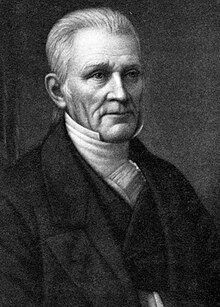Colonel Robert Gibbon Johnson
|
Colonel Robert Gibbon Johnson |
|
|---|---|

His customary style was a ruffled shirt with his silvery hair in a queue.
|
|
| Born |
July 23, 1771 Salem, New Jersey, British America |
| Died | October 2, 1850 (aged 79) New Haven, Connecticut, United States |
| Resting place | St John's Episcopal Church, Salem, NJ |
| Alma mater | Princeton |
| Occupation | gentleman farmer |
| Organization |
|
| Known for | introduction of the tomato |
| Notable work | An Historical Account of the First Settlement of Salem, in West Jersey |
| Spouse(s) | Hannah Carney, Juliana Zantzinger |
| Children | Jane, Mary, Anna, Robert |
| Parent(s) | Robert Johnson, Jane Gibbon |
Robert Gibbon Johnson (July 23, 1771 – October 2, 1850), also known as Colonel Johnson, was an American gentleman farmer, historian, horticulturalist, judge, soldier and statesman who lived in Salem, New Jersey. He is especially renowned for the apocryphal story that he publicly ate a basket of tomatoes at the Old Salem County Courthouse in 1820 to demonstrate that they were not poisonous, as was supposedly commonly thought at the time. He was a keen antiquarian and wrote a history of Salem – An Historical Account of the First Settlement of Salem, in West Jersey – which was published by Orrin Rogers in 1839.
Johnson was the only child of his parents Robert Johnson and Jane Gibbon. He was born on 23 July 1771 at the home of his great-uncle, John Pledger – a large plantation in Mannington, New Jersey called the New Netherland Farm. He was visiting the farm in March 1778 when the British raided Salem during the Revolutionary War and killed several of the inhabitants. The British commandeered Pledger's house and Johnson was imprisoned with the family for several days. Still a young boy, he later led his mother away to safety.
His early education was in Pittsgrove where he was taught Presbyterianism by Reverend William Schenck. He was subsequently educated at Newark Academy in Delaware and Princeton from where he graduated in 1790. He had planned to practise law but instead concentrated upon agriculture for most of his life, managing the large family estate.
He married Hannah Carney on 19 June 1798. They had four children but the first two daughters died in infancy. Their third daughter, Anne Gibbon Johnson, survived and married a Philadelphia lawyer, Ferdinand Hubbell. Their fourth and last child, Robert Carney Johnson, married Julia Harrison and went on to inherit the family estate in Salem.
Johnson and his mother had moved into Salem town when his father had died. They had stayed in the house of his great-grandfather, Alexander Grant, which still stands today in Market Street. After marrying, he built a new house for the family in 1806–7 – Johnson Hall, also in Market Street. This was the first house built in Salem in the Federal style but has some idiosyncratic asymmetries, apparently for functional reasons. It is brick-built with two stories, five bays, a high roof with a balustrade and fine interior woodwork. Johnson wanted this house to remain in the family but it was sold to the county in 1922 and relocated when a new courthouse was built on the plot. But it still stands today nearby and houses the Chamber of Commerce, Visitors' Center and similar offices.
...
Wikipedia
